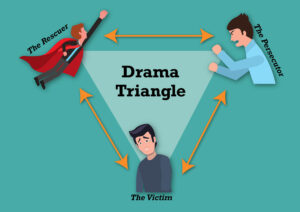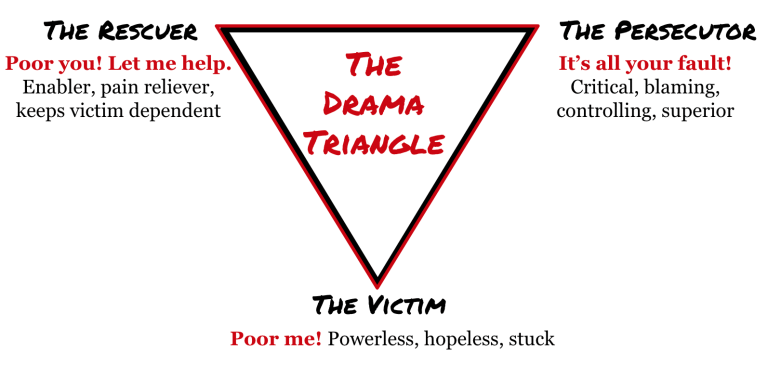
It’s a well-known fact that ships and planes can vanish without a trace in the Bermuda Triangle. In popular culture, this is usually linked to ghosts and other supernatural things, but those records and papers are not scientifically reliable.
A similar situation can happen at work, where there is a triangle that makes teamwork, goodwill, and efficiency disappear for no reason.
I wonder how many hours of work do we spend in this drama triangle week on week?
OK, what is that triangle?

Stephen Karpman, who was a student of Dr. Eric Berne, the founder of Transactional Analysis, came up with the triangle as a social model many years ago. It maps a pattern to this kind of dysfunctional interaction that happens at work and in our lives as well. “Dysfunctional” isn’t a bad word; it just means “not working well.”
In the 1960s, Dr. Stephen Karpman was the first person to talk about the drama triangle. The roles of victim, rescuer, and persecutor are all highly malleable, often blending into one another. Most of us are proficient in all three roles depending on the circumstances, but we all have a preference (typically the one we played most often as children).
Within this triangle, Dr. Karpman identified three points that always show up in real-life disordered dramas: the Persecutor, the Victim, and the Rescuer. We can choose to perform or leave all three roles at any time.
Care to explain?
Here are some examples of the triangle plot.
Suppose, for instance, an individual of your team has committed to providing an update on a crucial project by Tuesday afternoon. Wednesday morning has arrived. The report is still not with you. Here are three potential responses:
(1) “I was serious when I stated the report was due on Tuesday.”(Persecutor. This part tells the character, “It’s all your fault,” usually in the tone of a critical parent.)
(2) “Since I needed to see that report from you for three important meetings today, I’m going to fail at all three.” (The Victim. This part is all about saying “Poor me.”)
(3) “Send me whatever information you have and I’ll complete the report.” (Rescuer. This is the classic enabler.)
Although I sometimes do a convincing Victim, my go-to role is that of the Rescuer. Every time I helped someone in need, I felt heroic, powerful, and indispensable. After researching about this topic, I needed to change my views.
As a rescuer, you always put other people first and don’t have time for yourself. This is when you change into the victim. Although I was working hard to care for others, no one seemed to notice how much I appreciated it. I’d start to feel bitter and resentful, and before I knew it I’d start an argument with my wife or explode at an unsuspecting co-worker. In fact, I have become the Persecutor.
Notice how the drama shifts from one role to the next?
When one of these roles appears, or when you feel inclined to play one, you know the Drama Triangle is calling you… you’re about to be drawn into it. This is a common pattern: the boss strikes (Persecutor), the individual defends (Victim), and then the team helps (Rescuer). Is it truly feasible to continue doing this indefinitely?
It’s important to remember that The Drama Triangle is a game. For people who choose to play, the exchange will be centered on disagreement and denial, with few opportunities for resourcefulness, self-awareness, and win-win results.
Dr. Karpman says that this makes us switch between three traditional roles: Victim, Persecutor, and Rescuer. All three are just as harmful and chances of you breaking out is slim.
It’s not easy to spot the moments we slip into these roles, but being aware of the telltale signs might help you break the habit and move on. We will be able to get our work done faster if we break the cycle.
If you’re stuck in the drama triangle, here are five ways out.
- Find your place in the Drama Triangle
- Ask, “What can I do to help you?” OR share your knowledge with others.
- Be blunt… with careful consideration OR try a new approach.
- Inquire, “What else?” OR attempt uncharted territory.
- Listen OR Take Part in Listening
Find your place in the Drama Triangle
The first step towards altering the Drama Triangle pattern is acknowledging that it exists. If you know how to spot it, you’ll be able to break the pattern and figure out what created it. Step two on this list is for when you’ve identified the pattern and are ready to take action to break it.
Finding the pattern is the first step. The only way out of a dysfunctional relationship is to recognise its destructive dynamics and work to alter the only variable you can influence: your own actions.
Simply put, “How can I help you?”
Avoiding “Rescuer mode” requires you to first ask how you can help (instead of immediately offering suggestions). Instead of doing the work for your friends, by asking this question you are actually helping them do it. Because it means more work for them, this question can be intimidating to some (they may even try to “throw the monkey” on your back). That brings us to the next step: be honest about what you can offer.
Be direct… but use caution
You are essentially asking, “What do you want from me?” when you say, “How can I help?” And that’s not exactly an enticing prospect. You should avoid coming out as a whiner (Victim), an aggressor (Persecutor), or a smotherer (Rescuer). Recognise who you’re talking to. Although some of them might like this and be fine with direct questions, others need a softer approach, like saying “Out of curiosity…”, ”Just so that I know…” or the most prevalent “Help me understand better …”
To further explore, inquire “And what else?”
The coaching world has never seen a better question than this one. You can control your need to offer counsel by asking, “And what else?” this is a form of self-management. If you ask the right questions, you can help the other person come up with solutions and unearth hidden potential. Together, you and your co-worker can figure out what needs to be done, breaking the cycle of constantly switching roles from victim to persecutor to rescuer.
Just Listen
Everyone has the innate ability to make hasty judgements and come up with sage advice in the blink of an eye. While most people’s intentions are good, asking pertinent questions at the correct moment and being attentive to the answers can speed up the process significantly.
You can avoid being a Rescuer, Victim, or Persecutor by staying out of the Drama Triangle, wherein all three roles have negative connotations unless they are played very carefully.
My free advice –
Don’t just provide the answer when someone asks you a question. Talk to make oneself understood, but don’t forget to listen. That way, what you offer will be very useful, and you’ll have broken the pattern.


Hello there! This blog post couldn’t be written any better!
Looking through this article reminds me of my previous roommate!
He continually kept preaching about this. I am going to send this post to
him. Fairly certain he will have a great read. Thank you for sharing!